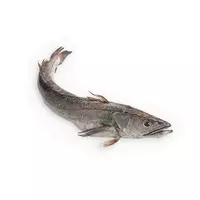Fish hake

Often, the usual culinary names of ingredients for us do not correspond at all to the real circumstance of things. For example, a well-known hake fish is actually called merlusa. Fish hake or merlouse belongs to the genus Merluz and consists of 10 similar species.
The hake fish lives mainly in the Atlantichsek or Pacific Ocean. The average size of a hake fish carcass usually does not exceed 30-50 cm, but this fish has its own record holders. There are large species of merloose, which reach a length of
1. 5 meters.
The following types of hake fish can be distinguished:
silvery hake or merlouse, which is mined off the coast of North America. This is a fairly large kind of hake.
Pacific merlusa or Oregon hake fish. This fish is found off the coasts of California, Washington and Oregon.
Argentine, New Zealand, Chilean and Cape hake are also distinguished. In cooking, hake fish has found a worthy use. There are a lot of recipes with this fish. Heck is considered one of the best fish to cook because it has very little bone.
The calorie content of the hake is obscenely small, a total of 86 Kcal per 100 grams of product. The heck contains almost no fat, which, combined with the low calorie content of the heck, makes the product indispensable in dietary nutrition. However, not only nutritionists advise their patients to eat as many hake fish as possible.
Benefits of the heck
If you pay attention to the composition of useful vitamins, minerals and natural compounds that are contained in the heck, then the uniqueness of the benefits of heck fish for the human body will immediately become obvious to you.
The composition of hake fish is replete with vitamins PP, B, A and E. Useful mineral compounds in the form of elements such as phosphorus, iron, iodine and calcium, as well as natural and perfectly digestible proteins that saturate your body. All this benefit from hake fish is increased with the help of the essential fatty acid Omega-3, which is found in the largest amount in the fish caviar.
Therefore, you can get double benefits from both hake fish and its caviar. Chefs professionals in fish cuisine will tell you that the most delicious dishes come from fried hake fish. The heck is cut, cut into pieces, salted and sprayed with lemon juice. They fry hake fish in oil (better on olive), as well as in batter. Boiled potatoes will fit the side dish to the fried heck. The hake fish works beautifully with cream or sour cream sauces with herbs.
hake fish 86 kKal
The energy value of hake fish (Ratio of proteins, fats, carbohydrates - ju):
Proteins: 16.6 (~ 66 kCal)
Fats: 2.2 g (~ 20 kCal)
Carbohydrates: 0 g (~ 0 kCal)
Energy ratio (b | y): 77% | 23% | 0%
 Español
Español Français
Français Português
Português Русский
Русский 简体中文
简体中文 繁體中文
繁體中文 日本語
日本語 한국어
한국어 العربية
العربية Türkçe
Türkçe Қазақ
Қазақ Deutsch
Deutsch Italiano
Italiano Українська
Українська
